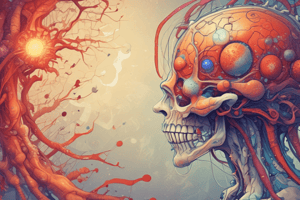Podcast
Questions and Answers
Which chemical mediators are responsible for vascular dilatation during acute inflammation?
Which chemical mediators are responsible for vascular dilatation during acute inflammation?
- Cytokines and chemokines
- Bradykinin and C5a
- Histamine, prostaglandins, nitric oxide (correct)
- Complement system components
Which of the following mechanisms contributes to increased vascular permeability?
Which of the following mechanisms contributes to increased vascular permeability?
- Vasoconstriction
- Direct injury from toxic burns (correct)
- Endothelial proliferation
- Increased capillary recruitment
What is the primary function of neutrophils during the inflammatory response?
What is the primary function of neutrophils during the inflammatory response?
- Release of cytokines
- Antibody production
- Phagocytosis (correct)
- Vasodilation
Which process describes the movement of neutrophils along concentration gradients of chemo-attractants?
Which process describes the movement of neutrophils along concentration gradients of chemo-attractants?
What role do integrins play during neutrophil emigration?
What role do integrins play during neutrophil emigration?
Which mediator is known for causing transient changes in vascular permeability during inflammation?
Which mediator is known for causing transient changes in vascular permeability during inflammation?
What is the term used to describe the digestion of the vascular basement membrane by neutrophils?
What is the term used to describe the digestion of the vascular basement membrane by neutrophils?
Which of the following chemicals is NOT a product of the neutrophil response in acute inflammation?
Which of the following chemicals is NOT a product of the neutrophil response in acute inflammation?
What role do opsonins play in microbial killing?
What role do opsonins play in microbial killing?
Which mechanism produces hypochlorous acid (HOCl) during the O2 dependent killing process?
Which mechanism produces hypochlorous acid (HOCl) during the O2 dependent killing process?
Which of the following is NOT a local complication of acute inflammation?
Which of the following is NOT a local complication of acute inflammation?
What is a common systemic effect observed during acute inflammation?
What is a common systemic effect observed during acute inflammation?
Which acute phase protein is clinically useful in assessing inflammation?
Which acute phase protein is clinically useful in assessing inflammation?
What is one potential sequela of acute inflammation?
What is one potential sequela of acute inflammation?
Which process reduces fever during an acute inflammatory response?
Which process reduces fever during an acute inflammatory response?
Which of the following best describes the resolution of acute inflammation?
Which of the following best describes the resolution of acute inflammation?
What is the primary causative organism of lobar pneumonia?
What is the primary causative organism of lobar pneumonia?
Which of the following treatments is used for Hereditary Angio-Oedema?
Which of the following treatments is used for Hereditary Angio-Oedema?
What effect does Bradykinin have in the context of Hereditary Angio-Oedema?
What effect does Bradykinin have in the context of Hereditary Angio-Oedema?
What is the predominant feature associated with exudate that has not developed a bacterial infection?
What is the predominant feature associated with exudate that has not developed a bacterial infection?
What occurs during the 'resolution by crisis' noted in lobar pneumonia?
What occurs during the 'resolution by crisis' noted in lobar pneumonia?
Which condition is characterized by recurrent severe swelling affecting various body parts?
Which condition is characterized by recurrent severe swelling affecting various body parts?
What is a significant consequence of α1-antitrypsin deficiency?
What is a significant consequence of α1-antitrypsin deficiency?
What complication can arise from a hepatic abscess?
What complication can arise from a hepatic abscess?
Flashcards
Phagocytosis
Phagocytosis
The process of a phagocyte engulfing a foreign particle, such as a bacterium.
Chemotactic factors
Chemotactic factors
Chemicals that attract phagocytes to the site of infection.
Phagocyte
Phagocyte
A type of white blood cell that engulfs and destroys pathogens.
Phagosome
Phagosome
Signup and view all the flashcards
Phagolysosome formation
Phagolysosome formation
Signup and view all the flashcards
Microbicidal mechanisms
Microbicidal mechanisms
Signup and view all the flashcards
Shock
Shock
Signup and view all the flashcards
Endogenous Pyrogen
Endogenous Pyrogen
Signup and view all the flashcards
Proteases: Key Players in Inflammation
Proteases: Key Players in Inflammation
Signup and view all the flashcards
Prostaglandins and Leukotrienes: Arachidonic Acid Derivatives
Prostaglandins and Leukotrienes: Arachidonic Acid Derivatives
Signup and view all the flashcards
Cytokines and Chemokines: Immune Messengers
Cytokines and Chemokines: Immune Messengers
Signup and view all the flashcards
Increased Vascular Permeability
Increased Vascular Permeability
Signup and view all the flashcards
Neutrophil Adhesion and Emigration
Neutrophil Adhesion and Emigration
Signup and view all the flashcards
Neutrophil Phagocytosis
Neutrophil Phagocytosis
Signup and view all the flashcards
Chemotaxis: Following the Chemical Trail
Chemotaxis: Following the Chemical Trail
Signup and view all the flashcards
Diapedesis: Neutrophils' Escape Route
Diapedesis: Neutrophils' Escape Route
Signup and view all the flashcards
Resolution in Inflammation
Resolution in Inflammation
Signup and view all the flashcards
Abscess
Abscess
Signup and view all the flashcards
Acute Inflammation in Serous Cavities
Acute Inflammation in Serous Cavities
Signup and view all the flashcards
Pericarditis
Pericarditis
Signup and view all the flashcards
Hereditary Angio-Oedema
Hereditary Angio-Oedema
Signup and view all the flashcards
α1-antitrypsin Deficiency
α1-antitrypsin Deficiency
Signup and view all the flashcards
Chronic Granulomatous Disease
Chronic Granulomatous Disease
Signup and view all the flashcards
Causative Organism of Lobar Pneumonia
Causative Organism of Lobar Pneumonia
Signup and view all the flashcards
Study Notes
Objectives of Acute Inflammation-2
- Chemical mediators (overview)
- More detail mechanism of fluid loss
- More detail neutrophil emigration
- Action of neutrophils-phagocytosis
- Local complications and systemic effects
- Sequelae
- Clinical examples
Chemical Mediators of Acute Inflammation
- Proteases: Plasma proteins produced in the liver.
- Kinins (Bradykinin and Kallikrein)
- Complement system (C3a, C5a)
- Coagulation/fibrinolytic system
- Prostaglandins/Leukotrienes: Metabolites of arachidonic acid.
- Synthesis blocked by Nonsteroidal anti-inflammatory drugs (NSAIDs), e.g., aspirin
- Cytokines/chemokines: Produced by white blood cells (WBCs).
- Many varied examples: Interleukins, platelet-activating factor (PAF), tumor necrosis factor-alpha (TNF-α), platelet-derived growth factor (PDGF), transforming growth factor-beta (TGF-β), etc.
Other Inflammatory Mediators
- From platelets: 5-HT, histamine, ADP
- From neutrophils: Lysosomal constituents
- Products released upon neutrophil death
- From endothelium: Prostacyclin, nitric oxide
- Plasminogen activators/inhibitors
- Oxygen-derived free radicals
- Endothelial damage, inactivation of antiproteases, injury to other cells
Vascular Changes
- Vascular dilatation: Histamine, prostaglandins, nitric oxide
- Increase in vascular permeability: Transient (histamine), bradykinin, leukotrienes (C4, D4, E4)
- Emigration of neutrophils: C5a, leukotriene B4, bacterial products
Mechanisms of Vascular Leakage
- Endothelial contraction --> gaps (histamine, leukotrienes)
- Cytoskeletal reorganization --> gaps (cytokines IL-1 and TNF)
- Direct injury (toxic burns, chemicals)
- Leukocyte-dependent injury (toxic oxygen species and enzymes from leukocytes)
- Increased transcytosis (channels across endothelial cytoplasm – VEGF)
Mechanisms of Neutrophil Migration
- Neutrophil adhesion and emigration due to binding of complementary adhesion molecules on endothelial and neutrophil surfaces
- Chemical mediators changing surface expression or avidity of adhesion molecules
- Selectins
- Immunoglobulins
- Integrins
How do Neutrophils Escape from Vessels
- Relaxation of inter-endothelial cell junctions
- Digestion of vascular basement membrane
- Movement (diapedesis and emigration; chemotaxis)
Chemotaxis
- Movement along concentration gradients of chemo-attractants
- Receptor-ligand binding
- Rearrangement of cytoskeleton
- Production of pseudopod
Phagocytosis
- Contact, Recognition, Internalization
- Cytoskeletal changes (as with chemotaxis)
Microbial Killing
- Recognition facilitated by opsonins (e.g., C3b receptors on phagocytes recognizing organisms coated with immunoglobulin or complement).
- Phagosomes fuse with lysosomes to produce secondary lysosomes.
Killing Mechanisms
- O2-dependent:
- Produces superoxide and hydrogen peroxide
- H2O2-Myeloperoxidase-halide system – produces HOCl
- Myeloperoxidase-independent killing less efficient
- O2-independent:
- Lysozyme & hydrolases
- Bactericidal Permeability Increasing Protein (BPI)
- Cationic proteins ('defensins')
- Major Basic Protein (MBP; eosinophils)
Complications of Acute Inflammation
- Local: Rubor, calor, dolor, tumor (redness, heat, pain, swelling)
- Systemic: Effects on the whole body
Local Complications of Acute Inflammation
- Swelling: Blockage of tubes (e.g., bile duct, intestine), exudate, compression (e.g., cardiac tamponade — serositis), loss of fluid (e.g., burns), pain & loss of function (especially if prolonged).
Systemic Effects of Acute Inflammation
- Acute phase response: Decreased appetite, altered sleep patterns, raised heart rate, changes in plasma concentrations of acute-phase proteins.
- C-reactive protein (CRP)
- 1-antitrypsin
- Haptoglobin
- Fibrinogen
- Serum amyloid A protein
- Spread of micro-organisms and toxins
- Shock: A clinical syndrome of circulatory failure
Systemic Effects of Acute Inflammation (Continued)
- Fever: Endogenous pyrogens (IL-1 and TNF) produced; influence of prostaglandins (aspirin reduces fever).
- Leukocytosis: IL-1 and TNF accelerate marrow release; macrophages and T lymphocytes produce colony-stimulating factors; bacterial infections — neutrophils; viral infections — lymphocytes
Acute Inflammation: Sequelae
- Complete resolution
- Continued acute inflammation with chronic inflammation; chronic suppuration (abscess).
- Chronic inflammation and fibrous repair, possibly with tissue regeneration
- Death
Resolution
- Mediators have short half-lives and inactivated by degradation, dilution or inhibition.
- Gradually, all acute inflammatory changes reverse, vascular changes stop, neutrophils stop marginating, vessel permeability and calibre return normal.
- Exudate drains via lymphatics; fibrin degraded by plasmin/other proteases; neutrophils die.
Resolution (Continued)
- Damaged tissue may regenerate, but if architecture destroyed, complete resolution not possible.
Clinical Examples: Lobar Pneumonia
- Causative organism: Streptococcus pneumoniae (“pneumococcus”)
- Population at risk: Young adults in confined conditions, alcoholics...
- Clinical course: Worsening fever, prostration, hypoxaemia over a few days, dry cough; fairly sudden improvement (“resolution by crisis”) when antibodies appear.
Skin Blister
- Causes: Heat, sunlight, chemical
- Predominant features: Pain, exudate (collection of fluid that strips off overlying epithelium; more pain, more tissue damage)
- Inflammatory cells relatively few (therefore exudate clear unless bacterial infection develops)
Abscess
- Solid tissues and exudate forces tissues apart
- Liquefactive necrosis in center (can cause high pressure and pain)
- May cause tissue damage and squash adjacent structures
Hepatic Abscess
(Image of a section of a liver with an abscess)
Acute Inflammation in Serous Cavities
- Exudate pours into cavity (ascites, pleural or pericardial effusion)
- Respiratory or cardiac impairment
- Localized fibrin deposition; in pericarditis, pericardium becomes inflamed and increase pressure on the heart.
Pericarditis
(Image showing a microscopic view of pericarditis and a macroscopic view of a heart with pericarditis).
Disorders of Acute Inflammation: Hereditary Angioedema
- Recurrent episodes of severe swelling (limbs, face, intestinal tract, airways)
- Caused by a deficiency of C1 inhibitor
- C1 is a complement protein that cleaves C2 and C4 to form C3
- C1 inhibitor inhibits not only C1 but also Bradykinin
- Uninhibited bradykinin greatly increases vascular permeability, causing edema
- Treatment: C1 inhibitor infusion or fresh frozen plasma.
α1-Antitrypsin Deficiency
- α1-antitrypsin inhibits elastase
- Without inhibition, elastase breaks down lung/liver tissue
- Causes emphysema and liver sclerosis.
Chronic Granulomatous Disease
- Recessive, sex-linked
- Immune phagocytes do not function properly
- Granulomas formed to contain bacteria
- Individuals with this disease likely to have recurring infections (lungs, skin, lymph nodes, liver, and intestine).
Studying That Suits You
Use AI to generate personalized quizzes and flashcards to suit your learning preferences.




